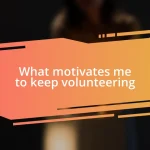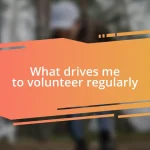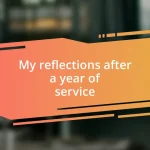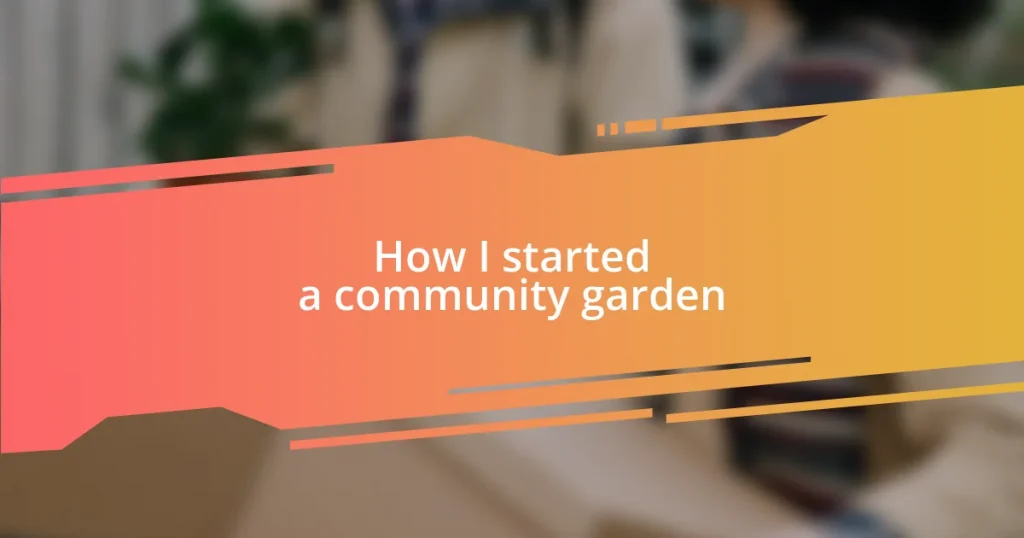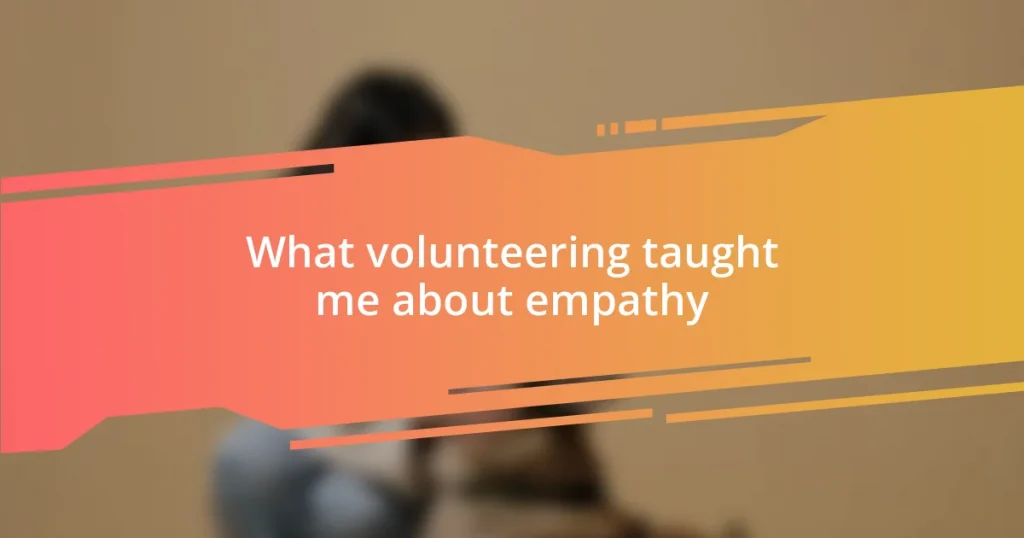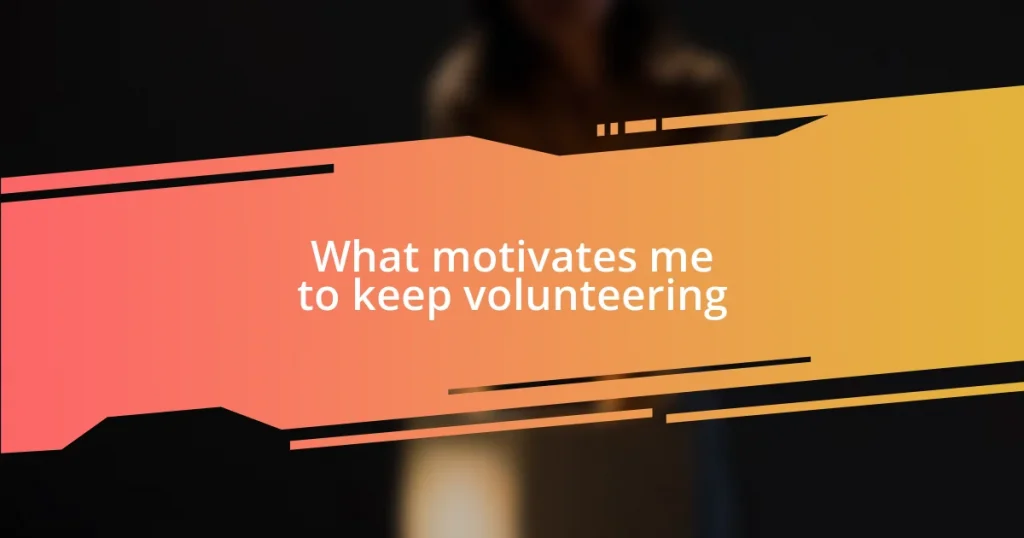Key takeaways:
- Choosing a suitable location involves ensuring adequate sunlight and community accessibility to foster inclusivity.
- Gathering community interest is essential; utilizing casual conversations, flyers, and meet-ups can enhance participation and connection.
- Establishing maintenance routines and celebrating collective achievements creates a sense of community ownership and joy in the gardening experience.

Choosing a Suitable Location
Choosing a suitable location for your community garden can feel like finding the perfect spot for a hidden treasure. When I was looking for a location, I found myself drawn to an empty lot that had been neglected for years. Imagine the transformation: from a patch of weeds to a flourishing green oasis. Isn’t it exciting to think about the potential of such a place?
Sunlight is vital for plant growth, so I focused on areas that received at least six hours of direct sunlight each day. I remember one location that seemed ideal until I realized it was shaded by a large tree. The disappointment was real; I had envisioned vibrant vegetables thriving there. So, I urge you to observe your prospective site during different times of the day. How much sun does it get? This little detail can make all the difference.
Accessibility is another important factor. You want your garden to be welcoming to everyone in the community. When I chose my location, I made sure it was near public transport and had enough space for wheelbarrows and visitors. Think about who will be involved—how can you make it easy for everyone to join in? Your garden should feel like a shared space, and accessibility plays a huge role in that feeling.

Gathering Community Interest
Once I decided on a suitable location, the next step was to gather interest from my neighbors. I vividly remember standing in front of my house one sunny Saturday, chatting with passersby about the idea. It was amazing how quickly curiosity sparked—people were genuinely interested! I learned that sharing my vision in a casual setting made others feel invited to participate and voice their own ideas.
Creating flyers was another effective strategy for engagement. I designed colorful, eye-catching flyers that outlined the benefits of a community garden and included a few engaging questions. I placed them in local shops and community boards. When I handed them out, I noticed people’s eyes twinkling with enthusiasm. It was as if the idea of nurturing plants together reminded them of their childhood gardens.
Lastly, I organized a small meet-up at a nearby café to gauge interest and brainstorm ideas. The turnout exceeded my expectations! Everyone shared their gardening stories, dreams, and even concerns. This collaboration fostered a sense of camaraderie, as we all resonated on the emotional level of growing something together. Building connections in the community was truly rewarding, and I could see how our garden project was beginning to bloom even before planting a single seed.
| Method | Description |
|---|---|
| Casual Conversations | Talking with neighbors and passersby to gauge interest and share the vision. |
| Flyers | Creating engaging flyers that outline benefits and encourage participation. |
| Meet-Ups | Organizing small gatherings to brainstorm ideas and foster a sense of community. |
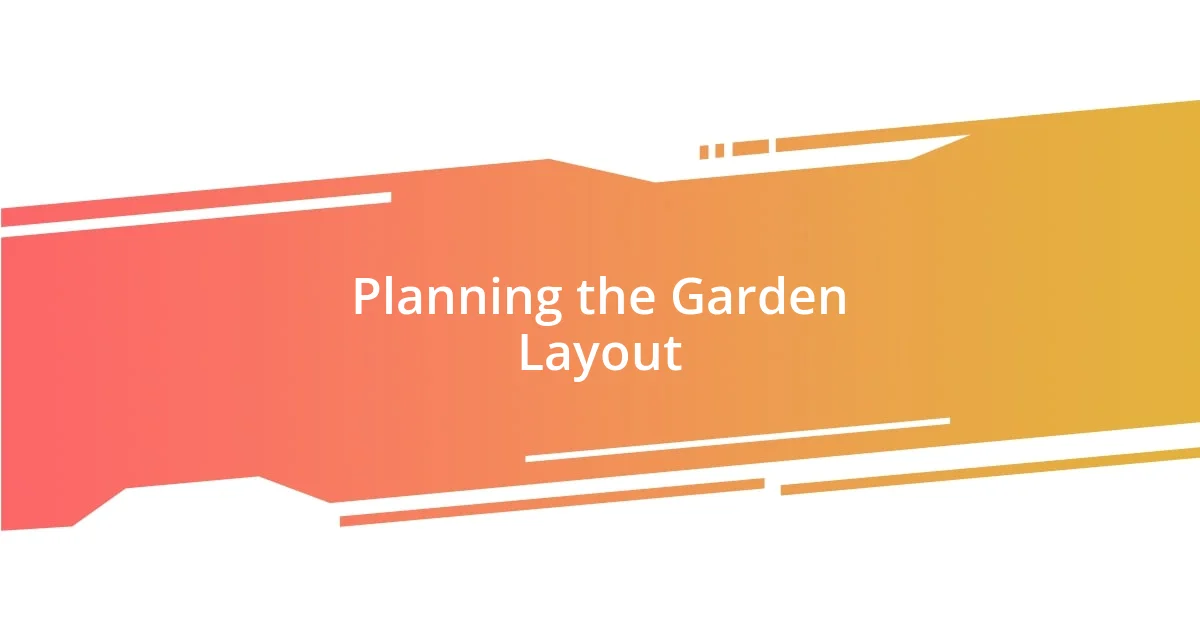
Planning the Garden Layout
When I dove into the planning of the garden layout, it was like putting together a puzzle. I started by sketching out the area on a piece of paper, visualizing not only where each plant could thrive but also how people would flow through the space. I remember getting so excited to designate specific zones for vegetables, herbs, and even a few flowers. It felt crucial to plan pathways that would invite conversation and camaraderie, ensuring folks could gather and share stories as they tended to their plants together.
- Sunlight Zones: Mark areas with optimal sunlight for various plants.
- Raised Beds: Consider elevated beds for easier access and to enhance the aesthetic appeal.
- Walking Paths: Design wide enough paths that encourage interaction and make maintenance easier.
- Community Areas: Allocate a spot for benches or picnic tables, creating space for gatherings and celebrations.
- Water Access: Identify locations for watering systems or hoses that won’t disrupt the flow of the garden.
Taking the time to carefully lay out these dimensions felt deeply rewarding. Each decision was an opportunity to create a space where everyone felt a sense of belonging. I remember the joy of imagining my friends and neighbors planting seeds in the spring sun while sharing laughter and stories—what a beautiful picture that was!

Selecting the Right Plants
Selecting the right plants for a community garden is one of the most exciting yet crucial decisions you’ll make. I remember standing at a local nursery, surrounded by rows of vibrant plants, contemplating what would truly thrive in our shared space. It struck me how each plant choice could foster not just growth, but also a sense of unity within our community. I often wonder, how do you decide which plants resonate with both your garden’s needs and your community’s preferences?
In my experience, I found it essential to consider the local climate and soil type. For instance, in our area, tomatoes thrived while delicate herbs struggled to take root. It was a learning curve, but being in tune with what would work meant more success stories to share with my neighbors. One day, as we planted the first batch of peppers, I felt a shared sense of pride radiating through the group. It was uplifting, knowing that our choices were not just about gardening but about coming together for a common cause.
Furthermore, involving the community in the selection process added a layer of joy to the experience. I asked everyone to share their favorite vegetables or flowers, which sparked delightful conversations. Imagine the excitement when we decided to plant a variety of beans that some members had grown up eating! I can still hear their laughter as they shared recipes and gardening tips. This engagement not only enriched our garden but also deepened our connections, making each plant a reminder of our collective journey. How often do we get to nurture something together while forging friendships?

Organizing Resources and Budget
Organizing the resources and budget for a community garden felt daunting at first, but it ultimately became a rewarding part of the process. I remember sitting down with a notepad, jotting down everything we might need, from seeds and soil to garden tools and water sources. It was important to prioritize our needs versus wants—sure, a fancy compost bin would be nice, but did we really need it right away? That thought process helped to keep our budget manageable and focused on essentials.
One pivotal moment occurred when we decided to host a fundraiser to support our initial expenses. I reached out to local businesses for donations, and their enthusiastic responses surprised me. I realized how willing the community was to support a project that promoted local agriculture and engagement. Not only did we raise some much-needed funds, but we also fostered deeper relationships with nearby shops—something I hadn’t anticipated. Have you ever experienced a moment where a simple idea snowballed into something greater? That’s exactly what happened for us, as our small fundraiser blossomed into a larger community event, involving live music and local foods.
As we settled into a rhythm, I learned the importance of keeping track of our expenses and contributions. I created a shared spreadsheet accessible to everyone involved, which encouraged accountability and transparency. Seeing the cost breakdown made it easier for us to plan future projects, like adding more plant beds or upgrading our tools. It was about building trust and collaboration among us; I think that made each person feel invested and deeply connected to the garden’s continued growth. How can a simple budget become a catalyst for community spirit? In my case, it truly laid the foundation for a shared journey in gardening and friendship.
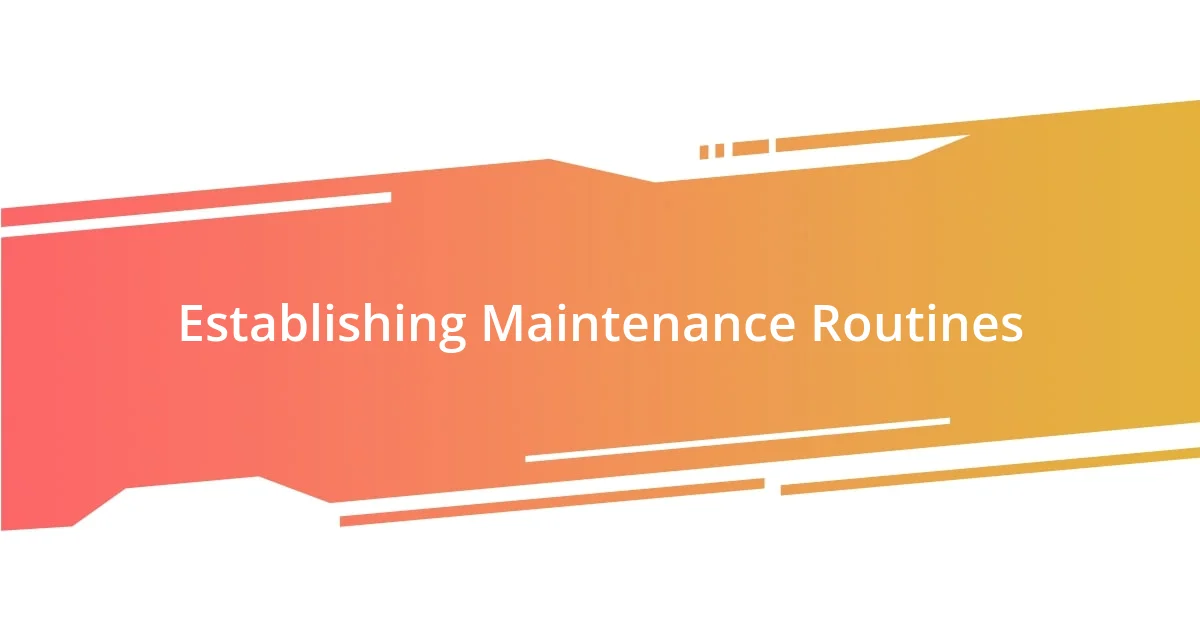
Establishing Maintenance Routines
Establishing maintenance routines became a lighthouse guiding our community garden through various seasons. At first, I was worried about keeping everything organized, but then I realized how vital it was to involve everyone in this process. We created a shared maintenance calendar, where each member signed up for specific tasks, from watering to weeding. I can still picture the moment we gathered around a table, each of us excitedly staking our claim to a part of the garden—it was like choosing your own plot of land in a grand adventure!
As the weeks rolled by, I found that regular check-ins really helped us bond. We set aside time every Sunday to meet, share stories, and tackle maintenance together. There’s something oddly satisfying about pulling weeds while sharing a good laugh or discovering a new insect together. I still chuckle at that one Sunday when a butterfly seemed to playfully follow us around like it was part of the team. Can maintenance be fun? Absolutely! Engaging with nature and each other turned what could have been mundane tasks into cherished moments.
Looking back, I’m proud of how we created a culture of accountability and enjoyment around our routines. We learned to adapt as we faced challenges, like those unexpected dry spells. I spearheaded an initiative to have a community watering day, making it into a social event where we brought snacks and highlighted our garden’s progress. Have you ever turned a task into a celebration? I found that our garden maintained not only the plants but also the connections we nurtured, making every weed pulled a step closer to community growth.
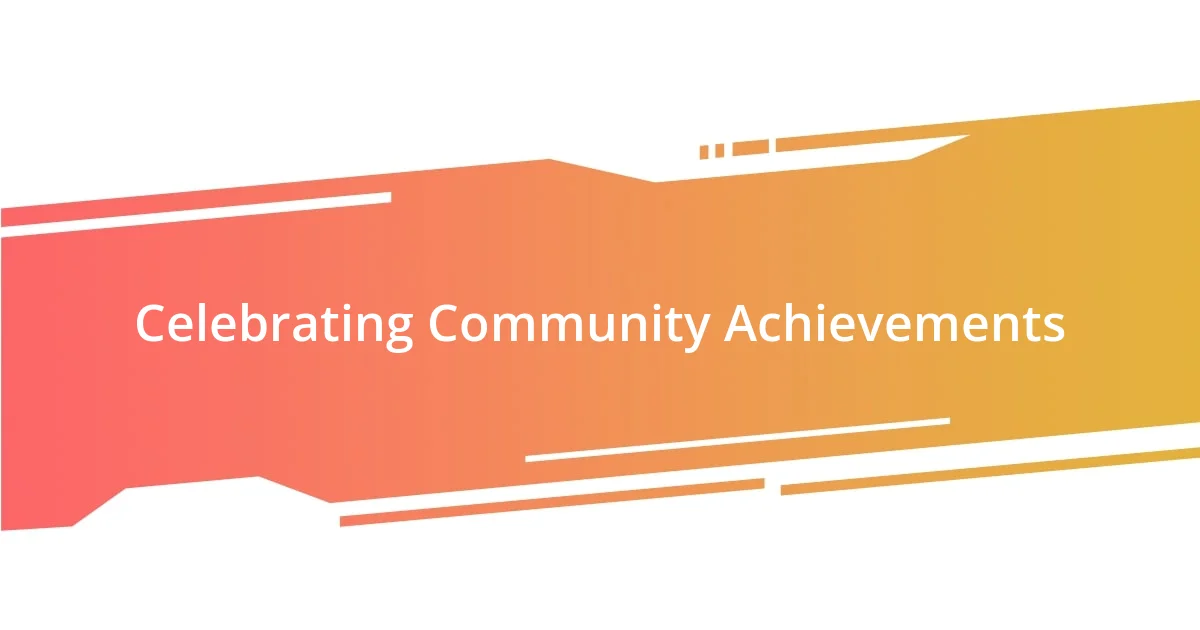
Celebrating Community Achievements
One of the highlights of starting our community garden was celebrating our collective achievements. I still remember the day we harvested our first batch of vegetables; the excitement in the air was palpable. Everyone gathered around, smiles beaming as we filled baskets with bright tomatoes and crisp cucumbers. It was a moment of pure joy, a shared triumph that reaffirmed our hard work and dedication. Isn’t it fascinating how something as simple as sharing produce can forge such strong bonds among people?
As the seasons changed, we organized community gatherings to celebrate our progress. Each event became a tapestry of laughter and storytelling, with each member sharing their unique experiences and favorite garden tips. I found it heartwarming to hear how individuals felt a sense of ownership and pride in our collaborative achievements. Have you ever witnessed how a shared experience can uplift a community? For us, the garden became more than just plants—it transformed into a space where friendships flourished and skills were shared.
Looking back, I can’t help but feel grateful for those moments of celebration. They filled our garden with life and laughter, reminding us that our efforts were not just about growing vegetables but growing together as a community. It’s incredible how these celebrations ignited a sense of purpose among us. Each achievement, big or small, reinforced our connection and commitment. Isn’t it wonderful when a simple garden can cultivate both crops and camaraderie?


